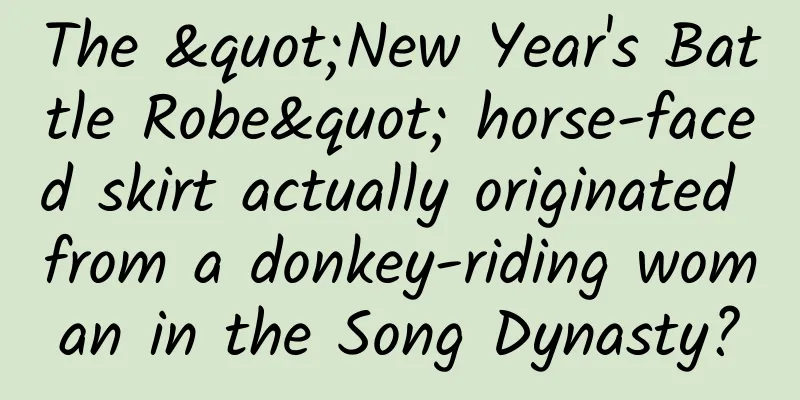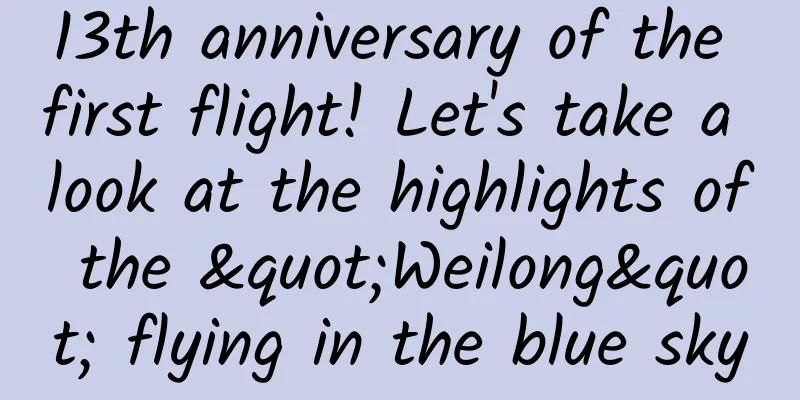The "New Year's Battle Robe" horse-faced skirt actually originated from a donkey-riding woman in the Song Dynasty?

|
Why did the horse-faced skirt become the "New Year's uniform" in the Year of the Dragon? Wear a horse-faced skirt in the Year of the Dragon Longma spirit all year round! This Spring Festival, the horse-faced skirt, a traditional Chinese clothing called "New Year's battle robe", became popular, driving a wave of traditional cultural consumption. Big data from multiple e-commerce platforms show that since January this year, the search volume for Hanfu has skyrocketed, among which the horse-faced skirt has become the most popular item under the Hanfu category, and the sales of many hot-selling items have exceeded one million yuan. In Cao County, Shandong, the sales of the Dragon Year New Year's greetings clothing, which is mainly horse-faced skirts, exceeded 300 million yuan (the editor was shocked). Why did the horse-faced skirt become the "New Year's uniform" in the Year of the Dragon? Let me tell you. In the impression of many consumers, the horse-faced skirt first appeared in the public eye in July 2022 when a certain international brand "plagiarized the horse-faced skirt". At that time, on the streets of Paris, France, many Chinese and international students wore Hanfu and held signs to protest, calling on the international brand to stop cultural appropriation. Since then, the horse-faced skirt has returned to the public eye, and related traditional costumes have also begun to be liked by more and more people, and sales have been hot during the Spring Festival. So what are the characteristics of the horse-faced skirt? The term "horse-faced skirt" first appeared in "History of the Ming Palace" by Liu Ruoyu in the Ming Dynasty, which refers to "the back is continuous, with swings on both sides, the front is divided into two parts, and there are horse-faced pleats at the bottom, rising to both sides". Its name comes from the ancient city walls in my country, and the square tower-like building structure is called "horse-faced skirt". Knowing what a horse-faced skirt looks like, you can also remember the horse-faced skirt vividly. The horse-faced skirt originated in the Ming Dynasty, continued in the Republic of China, and developed fastest in the Qing Dynasty. However, the history of the horse-faced skirt can be traced back to the Song Dynasty. In order to facilitate donkey riding, women in the Song Dynasty designed a functional "open-hip skirt" - a spiral skirt, which is similar to the horse-faced skirt. The spiral skirt is composed of two independent skirts of equal area. The two skirts are partially overlapped and then sewn to the waist of the skirt. Compared with the traditional lower skirt, this spiral skirt is more convenient for the lower body to move. At the beginning, literati and scholars criticized the spiral skirt for being immoral, but later they followed the trend and put on the horse-faced skirt and found it really good. Speaking of which, the horse-faced skirt can also be regarded as China's early cycling clothes. The long clothes are elegant and graceful, solemn and polite, and convenient. The spiral skirt of the Song Dynasty gradually developed into the horse-faced skirt in the Ming Dynasty, which can be worn by both men and women. The horse-faced skirt of the Qing Dynasty, on the basis of inheriting the skirt style of the Ming Dynasty, gradually evolved into the daily dress of Han women in the Qing Dynasty through further evolution, and became the iconic skirt style of women in the Qing Dynasty. How do we distinguish the horse-faced skirts of the Ming and Qing Dynasties? The Ming Dynasty horse-faced skirt usually uses 7 pieces of cloth, 3 and a half pieces of cloth are pieced together to form a skirt, and two pieces of cloth are enclosed to form a skirt; the front and back of the skirt are overlapped, and the two sides are pleated, fixed with a different-colored waistband, and laces are sewn on both ends of the waistband; the skirt is wide, and the hem is decorated with woven or embroidered decorations, or knee-length. The patterns on the skirt are often auspicious patterns with rich meanings, while women from official families use more sophisticated dragon patterns, cloud and python patterns, etc. The Ming Dynasty horse-faced skirt is dignified and elegant. It has been passed through a hundred years and is still as beautiful as ever. The decoration of the horse-faced skirt and skirt of the Qing Dynasty was more complicated, with fine and dense pleats, some with more than a hundred pleats, and the skirt became a dead pleat, with edging between the pleats. Therefore, the horse-faced skirt of the Qing Dynasty we see pays more attention to embroidery and edging, and has false pleats with complex decorations on both sides, and the number of pleats is also denser. The exquisite embroidery patterns on the skirt are a perfect display of the exquisite traditional Chinese women's needlework skills. To this day, through the existing cultural relics in the museum, such as the Qing Dynasty green-ground phoenix-patterned horse-faced skirt collected by the Boston Museum of Fine Arts, the Qing Dynasty yellow-ground colored embroidered flower horse-faced skirt that appeared at the China Guardian Fourth Quarter Auction in 2015, the late 19th century horse-faced skirt with phoenix and peony embroidery at the New York auction in 2008, as well as relevant information recorded in literature, we can clearly see that the meaning of the patterns, color matching, and distribution of patterns of the horse-faced skirt changed with the changes in historical periods. As a material cultural heritage, the horse-faced skirt has spanned thousands of years. After the continuous integration of life customs and clothing culture in the changing times, it still remains today and can be called a classic. How can China's material cultural heritage be innovated? How can traditional clothing be integrated into daily life aesthetics and clothing design? Regarding Chinese traditional clothing, we look forward to the unfinished chapter. |
<<: This common "birthmark" may be a disease: "coffee spots" that cannot be ignored
Recommend
Why do users click on your game feed ads but fail to convert?
The reason why those real users did not convert m...
Are you scared of measuring your blood pressure at home? New research shows that many people are doing it wrong →
Compiled by: Gong Zixin now More and more familie...
IHS: China's industrial robot market value reached US$1.3 billion in 2015, with a compound annual growth rate of 20%
On April 20, 2016, according to statistics from I...
Community Operations
Is the community really out now? Nowadays, it see...
Recommend 5 information flow advertising case libraries, take them for free!
It is really difficult to make information flow a...
What work should be included in the bidding hosting service contract?
First of all, let me explain to you that a biddin...
WeChat application numbers are here, what should you do with your own APP?
Many people know that WeChat is developing a prod...
WeChat's anxiety, anxious WeChat
Key points of this article More modules, more con...
Inventory of marketing cases of big-name manufacturers in Q1 2021
Spring is here and summer is approaching. In the ...
Analysis of WeChat Reading’s user growth strategy!
Even with the support of WeChat, a huge traffic p...
AARRR model, analyzing Himalaya’s membership growth!
The AARRR funnel model is also known as the Pirat...
Too sudden! A famous actor died of cancer. This disease is often diagnosed in the middle or late stages...
According to his niece Meng Xilin, the famous Hon...
Google's "AI Guess the Picture" app is popular on WeChat Moments: user participation makes it smarter
One day after its launch, Google's first WeCh...
Ejection seat, the skyguard of the skyguard
Some people say that the last line of defense to ...
How does Bilibili charge for advertising? B station latest advertising cooperation price
Bilibili Advertising Center/Bilibili Advertising ...









